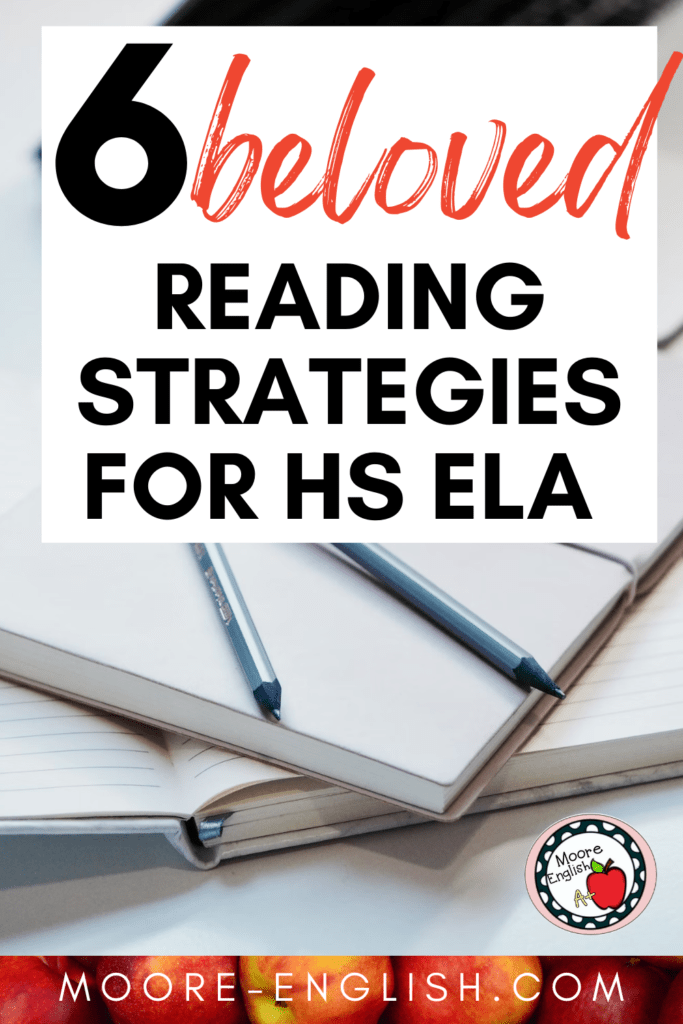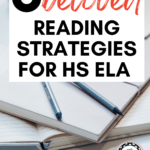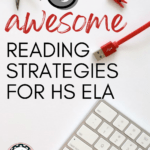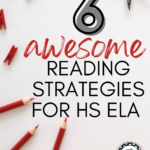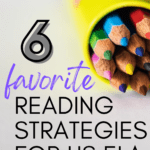Recently, I watched a YouTube video about a basic makeup kit. The premise was “if you could only have a few makeup products, what would you keep?”
I’m no makeup guru, but I do know what reading strategies belong in my teacher kit. These are my ride-or-die reading strategies. Perhaps these are not the trendiest or most glamorous or buzziest strategies, but these are tried-and-true, truest blue reading strategies.
I have taught pretty much everything 9-12 ELA, and these work. every. single. time.
This post this post may contain affiliate links. Please read the Terms of Use.
Let’s Learn from our Elementary Friends
Some of my favorite reading strategies sometimes get a rap for being “too elementary” (whatever that means). However, that criticism has never come from my students. Students often like a familiar pattern or learning experience. When they feel safe, they feel comfortable enough to take an academic risk or to approach a challenging text.
- First, guided reading absolutely has a place in the high school classroom. This is both a scaffolding and intervention strategy!
- Second, anchor charts are one of my most frequently used instructional strategies. I build anchor charts with students, and we reference them throughout a unit or course. Anchor charts are such a strong part of spatial and retrieval practice.
- Maybe my favorite anchor chart is about using RECEIPTS to teach author’s purpose. This is a change I made a few years ago to teach students about author’s purpose beyond P-I-E. Read more about how I teach author’s purpose.
Pre-Reading
As a new teacher, I laughed off pre-reading strategies. (Oh, the hubris of youth!) However, these two pre-reading strategies are an absolute must! Of the strategies described here, these are the two reading strategies I use the most because my students use them every single time we read.
- 4 Steps for Pre-Reading Poetry: Poetry is so intimidating for students, so these pre-reading strategies empower students to engage ANY poem. I’ve learned that when a student says “I hate poetry,” what they really mean is “I don’t know how to read poetry.” These pre-reading steps help students move beyond that argument!
- 4 Steps for Pre-Reading Nonfiction: Because my students had so much success with pre-reading poetry, I also developed this set of strategies for pre-reading nonfiction. Of the two pre-reading strategies, this is the one students use the most in standardized testing.
Reading Strategies with Meaningful Movement
Classroom movement is an undervalued reading strategy. For one, meaningful movement helps students stay engaged. For another, meaningful movement builds classroom community, and it can assist in differentiation.
- I love stations! Whether digital or in-person, stations are a great way to keep students engaged. These 7 Literary Analysis Stations include so many different reading strategies and can be used with anything students are reading.
- Gallery walks are another underrated activity. Place a different reading strategy at each space in the gallery walk, and students will be able to attack a text from every angle!
- Teachers can also use task cards with your stations or as part of a gallery walk. The grab-and-go nature of task cards makes them the perfect way to implement a variety of reading strategies.
Mentor Texts for the Win
Choosing mentor texts is another instructional strategy that knows no grade level! However, gathering mentor texts all in one place can be a challenge. You have to choose texts that target a specific skill, are of a reasonable length, are school appropriate, will engage students, and are at the right reading level! That is a lot to juggle, so I have put mentor texts together all in one place.
- 9 Short Stories
- 5 Poems for Teaching Allusion
- 5 Poems for Teaching Story Elements
- 5 Poems for Teaching Characterization
- 5 Poems for Synthesizing Across Media
- 10 Meaningful Poems to Teach Main Idea
- 10 Powerful Poems for Teaching Point of View
- 12 Poems for Teaching Context Clues and Vocab
I also have batched together mentor texts for different eras of American literature. This helps me decide how to scaffold and spiral instruction without having to hem and haw about text choices.

